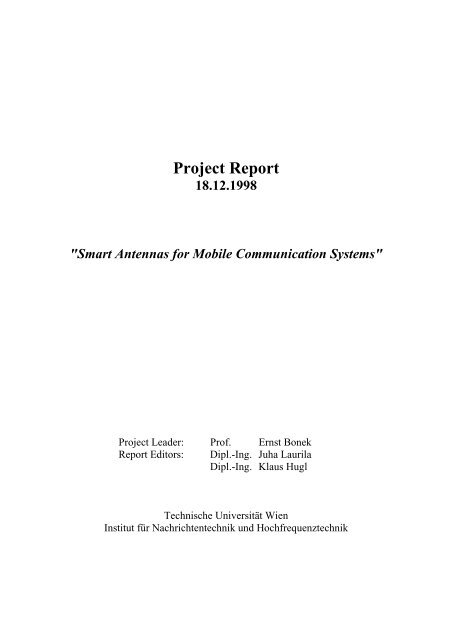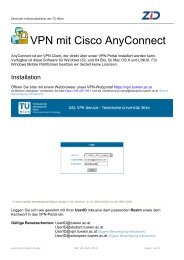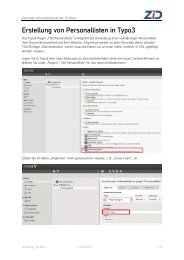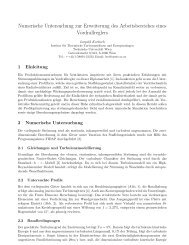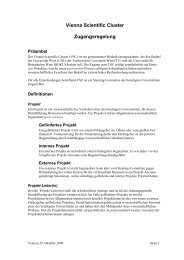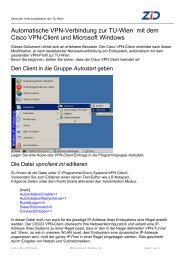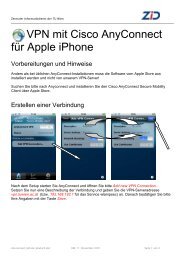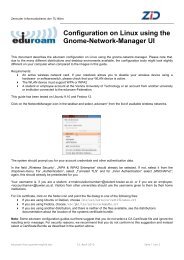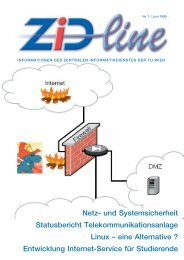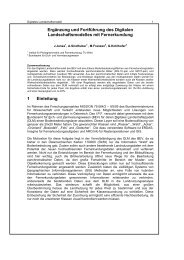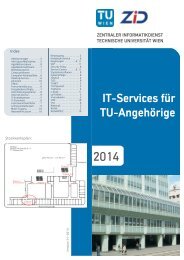Smart Antennas for Mobile Communication Systems - ZID ...
Smart Antennas for Mobile Communication Systems - ZID ...
Smart Antennas for Mobile Communication Systems - ZID ...
You also want an ePaper? Increase the reach of your titles
YUMPU automatically turns print PDFs into web optimized ePapers that Google loves.
Project Report<br />
18.12.1998<br />
"<strong>Smart</strong> <strong>Antennas</strong> <strong>for</strong> <strong>Mobile</strong> <strong>Communication</strong> <strong>Systems</strong>"<br />
Project Leader: Prof. Ernst Bonek<br />
Report Editors: Dipl.-Ing. Juha Laurila<br />
Dipl.-Ing. Klaus Hugl<br />
Technische Universität Wien<br />
Institut für Nachrichtentechnik und Hochfrequenztechnik
P-12147 MAT Project Report 1997-98<br />
1 INTRODUCTION 3<br />
2 PROJECT DOCUMENTATION 4<br />
2.1 Channel Modeling 4<br />
2.1.1 Introduction 4<br />
2.1.2 Parameter fitting of the GSCM 4<br />
2.1.3 Time variation of the spatial channel model 5<br />
2.1.4 Downlink channel model 5<br />
2.2 Downlink Algorithms 6<br />
2.2.1 Introduction 6<br />
2.2.2 Estimation of the spatial covariance matrix 6<br />
2.2.3 Null Broadening 7<br />
2.2.4 Beam<strong>for</strong>ming Algorithms 8<br />
2.2.5 Downlink Transmit Power 8<br />
2.2.6 Simulations and Results 9<br />
2.3 Receiver Imperfections and Calibration 9<br />
2.3.1 Introduction 9<br />
2.3.2 Model of Imperfections 10<br />
2.3.3 Simulations and Results 11<br />
2.3.4 Calibration Considerations 12<br />
2.4 Robust Algorithms (Blind and Semi-Blind Estimation) 13<br />
2.4.1 Introduction 13<br />
2.4.2 Subspace Estimation (Space-Time Equalisation) 14<br />
2.4.3 DILSF Algorithm 14<br />
2.4.4 Simulations and Results 15<br />
2.4.5 Testbed Software Implementation 16<br />
2.5 References 17<br />
3 PROJECT RELATED PUBLICATIONS 20<br />
"<strong>Smart</strong> <strong>Antennas</strong> <strong>for</strong> <strong>Mobile</strong> <strong>Communication</strong>s <strong>Systems</strong>" 2
P-12147 MAT Project Report 1997-98<br />
1 INTRODUCTION<br />
This document summarises the research activities carried out in the framework of the project "<strong>Smart</strong><br />
<strong>Antennas</strong> <strong>for</strong> <strong>Mobile</strong> <strong>Communication</strong> System". The project is based on the contract P-12147 MAT<br />
between Austrian Science Fund (Fonds zur Förderung der wissenschaftlichen Forschung, FWF) and<br />
Institut für Nachrichtentechnik und Hochfrequenztechnik, TU Wien (INTHF). The project started in<br />
May 1997 and this deliverable considers the achievements during the first two project years.<br />
The aim of the project is to contribute to the utilisation of adaptive antennas with the existing and<br />
<strong>for</strong>thcoming mobile communication systems. The focus of the research is to develop new signal<br />
processing schemes <strong>for</strong> adaptive antennas in mobile radio application. However, we have also<br />
carefully considered application specific issues like influences and restrictions caused by physical<br />
propagation phenomena and imperfect receiver hardware.<br />
This deliverable omits technical details, but gives an overview and acts as a guide to find more<br />
in<strong>for</strong>mation in the other project related publications with more technical nature. The section is divided<br />
further into subsections, each describing one of the following main activities:<br />
• Channel Modeling<br />
• Downlink Algorithms<br />
• Receiver Imperfections and Calibration<br />
• Robust Algorithms (Blind and Semi-Blind Estimation)<br />
"<strong>Smart</strong> <strong>Antennas</strong> <strong>for</strong> <strong>Mobile</strong> <strong>Communication</strong>s <strong>Systems</strong>" 3
P-12147 MAT Project Report 1997-98<br />
2 PROJECT DOCUMENTATION<br />
2.1 Channel Modeling<br />
2.1.1 Introduction<br />
Realistic spatial channel modeling is vital <strong>for</strong> the simulations of adaptive antenna systems. Only a<br />
channel model which reflects the radiowave propagation in typical environments, in the time as well<br />
as in the angular domain, can be used <strong>for</strong> simulations. Violation of this basic legitimacy may lead to<br />
wrong conclusions about the analysed algorithms and the system itself.<br />
The theoretical basis of the Geometry-based Stochastic Channel Model (GSCM) [FMB_98] was<br />
already existing be<strong>for</strong>e the current project. The model consists of scatterers 1 in the vicinity of the<br />
mobile station and the received signal is calculated by simple ray-tracing. The location of the<br />
scatterers is selected according to the appropriate PDF (probability density function). In addition, it is<br />
possible to include far scatterers which correspond to reflections from far obstacles, like mountains in<br />
rural environments or high-rise buildings in suburban and urban environments.<br />
In the framework of the current project we extended and parametrised the model to enable realistic<br />
simulations with different purposes and environments. For example, we have included the MS<br />
movement to be able to consider the time variation of the channel. Further, we had to fit the<br />
parameters of the model in a way that the characteristics like power delay profile (PDP) and azimuthal<br />
power spectrum (APS) agree with recent channel sounder measurements [Ped_97]. In addition to the<br />
modifications of the uplink channel model we created a corresponding downlink implementation with<br />
the same requirements.<br />
2.1.2 Parameter fitting of the GSCM<br />
The fundamental requirement <strong>for</strong> the spatial channel models is that the PDP and APS correspond to<br />
the distributions observed in the channel measurements. As discussed above, the distribution defining<br />
the location of the scatterers <strong>for</strong>ms the basis of the GSCM and determines also the responses at the<br />
receiving antennas in a straight<strong>for</strong>ward way. In our model we have considered three different PDFs <strong>for</strong><br />
the distance between the MS and the scatterers; Gaussian, Rayleigh and uni<strong>for</strong>m distributions<br />
[LSB_98]. Figure 1 shows the simulated azimuthal power spectra with these PDFs when only local<br />
scatterers were present. Comparison to the recent measurements results [Ped_97] shows that Gaussian<br />
distribution fits well to the measured Laplacian APS and it approximates properly also the exponential<br />
PDP of the well known stochastic COST 207 models. Corresponding considerations have been carried<br />
out also <strong>for</strong> the scenario with far scatterers. Our results show that parameter selection modeling urban<br />
environment with base stations above the rooftop level gives perfect fit with the COST 207 TU<br />
(typical urban) model (Fig. 3.)<br />
The investigations shown above are also possible by employing analytical bijective mathematical<br />
trans<strong>for</strong>mation between scatterer locations and resulting delays and DOAs (direction of arrival) at the<br />
receiver. Accordingly the measured joint ADPS (azimuthal delay power spectrum) can be trans<strong>for</strong>med<br />
to the scatterer constellation under the single scattering assumption [MLK_98], [Egg_98]. This<br />
enables direct parametrisation of the GSCM by utilising measured data.<br />
1<br />
Following the established notation in the literature we use word "scatterer" even if strictly speaking specular<br />
reflections are assumed.<br />
"<strong>Smart</strong> <strong>Antennas</strong> <strong>for</strong> <strong>Mobile</strong> <strong>Communication</strong>s <strong>Systems</strong>" 4
P-12147 MAT Project Report 1997-98<br />
2.1.3 Time variation of the spatial channel model<br />
In normal propagation environments buildings, hills and mountains act as the dominant reflectors.<br />
There<strong>for</strong>e the scattering points do not change their position when the MS moves through the scattering<br />
scenario. Further, in link level simulations we are typically interested in the short term variations of<br />
the mobile radio channel. For downlink beam<strong>for</strong>ming we have to carry out the parameter estimation<br />
by means of averaging, because the instantaneous downlink channel is not known due to the<br />
uncorrelated fading in different transmission directions. However, averaging over small-scale fading is<br />
adequate which corresponds to the mobile movement over 10-20λ. Notation λ denotes the wavelenght<br />
of the signal, being about 16 cm <strong>for</strong> GSM1800 frequencies.<br />
However, <strong>for</strong> some special simulation purposes it might be also relevant to consider longer term<br />
channel variations, which correspond to the movement of the MS over the hundreds of wavelenghts.<br />
For these situations we have proposed the special implementation of the GSCM, in which we locate<br />
scatterers uni<strong>for</strong>mly over the whole area under consideration be<strong>for</strong>ehand and we weight the scattering<br />
cross sections according to the MS movement during the simulation. We call this implementation<br />
NSCS, nonuni<strong>for</strong>m scatterer cross section [MKLH_98]. Additionally, we have also proposed to<br />
include other long-term effects, like shadowing, if needed.<br />
Normalised Power [dB]<br />
0<br />
−2<br />
−4<br />
−6<br />
−8<br />
−10<br />
−12<br />
−14<br />
−16<br />
−18<br />
Power Azimuth Spectra<br />
−20<br />
−8 −6 −4 −2 0 2 4 6 8<br />
Azimuth around the nominal DOA<br />
Fig. 1. APS <strong>for</strong> the GSCM Fig. 2. PDP <strong>for</strong> the GSCM<br />
2.1.4 Downlink channel model<br />
Rayl.−analytical<br />
Rayl.−simulation<br />
Uni<strong>for</strong>m<br />
Gaussian<br />
−30<br />
0 1 2 3 4 5 6 7<br />
Delay [us]<br />
Our downlink channel model has identical principle than the corresponding uplink implementation<br />
described above. Naturally, also the scattering points have same locations. The only required<br />
modifications <strong>for</strong> the downlink model were the time displacement between uplink and downlink<br />
transmission (e.g. three timeslots in GSM system) and different carrier and Doppler frequencies. The<br />
frequency shift between uplink and downlink, however, leads to fully uncorrelated channel responses.<br />
This modified uplink channel model and the corresponding downlink part were used in all the<br />
simulations described in this document.<br />
"<strong>Smart</strong> <strong>Antennas</strong> <strong>for</strong> <strong>Mobile</strong> <strong>Communication</strong>s <strong>Systems</strong>" 5<br />
Normalised power [dB]<br />
0<br />
−5<br />
−10<br />
−15<br />
−20<br />
−25<br />
Power Delay Profile − local & far scatterers<br />
Our Model<br />
COST 207 TU Profile
P-12147 MAT Project Report 1997-98<br />
2.2 Downlink Algorithms<br />
2.2.1 Introduction<br />
Uplink array processing is different to that of the downlink in an adaptive antenna system. In uplink<br />
reception we can react on the actual channel situation and several algorithms are proposed in literature<br />
(see overview in [Fuhl_97]) which promise large capacity gains.<br />
But in the downlink the channel is unknown. We have to extract the important parameters of the<br />
uplink channel to get an estimate of the downlink propagation situation if we want to prevent mobile<br />
station feedback [GP_96]. But the fading in up- and downlink is totally uncorrelated due to the<br />
different carrier frequencies in an FDD (Frequency Division Duplex) system. In downlink<br />
transmission the fading is unknown and there<strong>for</strong>e the unique possibility is to utilise the mean channel<br />
characteristics. Only the directions and the mean powers of the signal paths are the same in up- and<br />
downlink. As a consequence the gain of an adaptive antenna system is smaller by about 3-4dB in the<br />
downlink.<br />
The goal of a mobile communication system applying adaptive antennas is to get the same capacity<br />
increase in the downlink as in the uplink. There<strong>for</strong>e it is essential to develop signal processing<br />
methods which can cope with the problems of the downlink. Moreover the importance of the downlink<br />
part has increased dramatically in the last few years. Data transmission applications of cellular mobile<br />
communication systems, e.g. the Internet, require a higher downlink capacity compared to the uplink.<br />
In the downlink our goal is to select the weight vectors in a way that most of the power is transmitted<br />
to the desired user and the produced interference <strong>for</strong> the other users is kept as low as possible. We<br />
divide the weight calculation in four consecutive steps which are explained in the sequel. Our<br />
downlink beam<strong>for</strong>ming approach is illustrated in Fig. 1.2.1.<br />
Covariance<br />
Matrix<br />
Estimation<br />
Fig. 3. Consecutive steps of the downlink beam<strong>for</strong>ming process.<br />
2.2.2 Estimation of the spatial covariance matrix<br />
We used the spatial covariance matrix of the downlink channel <strong>for</strong> weight calculation purpose. The<br />
spatial covariance matrix contains all important in<strong>for</strong>mation of the mobile radio channel. Further it is<br />
the most flexible way because a lot of different beam<strong>for</strong>ming features like angular diversity or null<br />
broadening can be included in this system matrix with no need to change the used weight calculation<br />
approaches. We investigated two different methods to estimate the spatial covariance matrix at the<br />
downlink frequency.<br />
2.2.2.1 Direction based Approach<br />
Null<br />
Broadening<br />
Weight<br />
Calculation<br />
(Beam<strong>for</strong>ming)<br />
Transmit<br />
Power<br />
Calculation<br />
Herein we first estimate the dominating DOAs (directions-of-arrival) and the corresponding powers<br />
coming from that specific directions. For high-resolution DOA estimation we applied a spatial<br />
reference algorithms called Unitary ESPRIT [HN_95]. Afterwards the estimated DOAs are assigned to<br />
the specific users by utilising user identification algorithms. We allocated the DOAs ideally, because<br />
this was not part of our investigations. With these estimates on the hand you can create the spatial<br />
covariance matrices of the downlink<br />
"<strong>Smart</strong> <strong>Antennas</strong> <strong>for</strong> <strong>Mobile</strong> <strong>Communication</strong>s <strong>Systems</strong>" 6
P-12147 MAT Project Report 1997-98<br />
L<br />
H<br />
R = ∑ P ( Θl<br />
) a(<br />
Θl<br />
, f d ) a(<br />
Θl<br />
, f d ) ,<br />
l=<br />
1<br />
where a(Θl,fd) denotes the array steering vector of the direction Θl at the downlink frequency fd. The<br />
power values P(Θl) were estimated using a simple beam<strong>for</strong>mer.<br />
2.2.2.2 Trans<strong>for</strong>mation based Approach<br />
In an FDD system the frequency dependent array response vector and thus also the spatial covariance<br />
matrix changes significantly from up- to downlink. The idea of this approach was to estimate the<br />
spatial covariance matrix at the uplink and apply a frequency trans<strong>for</strong>mation. We investigated two<br />
already proposed algorithms, which should per<strong>for</strong>m this necessary conversion.<br />
The first approach uses a Compensation Matrix [Zet_97] utilising averaging over the angular domain.<br />
This compensation matrix decreases the error <strong>for</strong> small frequency shifts and inter-element distances of<br />
the antenna array. But this method changes also the mathematical structure of the spatial covariance<br />
matrix, as shown in [Hug_98].<br />
The Duplex Array Approach [RDJP_95] assumes dominant angles of arrival and small duplex<br />
frequencies. This restricts the application to narrowband systems and scenarios with negligible angular<br />
spread.<br />
Both methods did not lead us to satisfactory results. But especially this trans<strong>for</strong>mation will be<br />
important <strong>for</strong> 3 rd generation systems, where the number of users will exceed the number of available<br />
antenna elements by far and there<strong>for</strong>e makes the application of DOA based methods impossible.<br />
2.2.3 Null Broadening<br />
Null broadening should provide wide enough nulls in the antenna pattern to reduce the produced<br />
interference as far as possible. Array imperfections, calibration errors and a limited channel estimation<br />
accuracy (spatial covariance matrix or DOA) lead us to the urgency of null broadening. Especially in<br />
suburban and urban environments with large spreading of the user signals over the angular domain<br />
(angular spread AS), the per<strong>for</strong>mance loss without null broadening is considerable. As a consequence<br />
null broadening in such propagation environments is necessary. If we use exclusively discrete DOAs<br />
<strong>for</strong> covariance matrix approximation, the beam<strong>for</strong>ming algorithms produce sharp nulls in the<br />
directions of the interferers, illustrated in Fig. 1.2.2. We demonstrate the effect of null broadening on<br />
the antenna pattern in Fig. 1.2.3.<br />
dB<br />
0<br />
−10<br />
−20<br />
−30<br />
−40<br />
−50<br />
User1<br />
User2<br />
Antenna pattern<br />
−60<br />
−80 −60 −40 −20 0 20 40 60 80<br />
Azimuth in degrees<br />
−60<br />
−80 −60 −40 −20 0 20 40 60 80<br />
Azimuth in degrees<br />
Fig. 4. Antenna pattern without null broadening Fig. 5. Antenna pattern with null broadening<br />
"<strong>Smart</strong> <strong>Antennas</strong> <strong>for</strong> <strong>Mobile</strong> <strong>Communication</strong>s <strong>Systems</strong>" 7<br />
dB<br />
0<br />
−10<br />
−20<br />
−30<br />
−40<br />
−50<br />
User1<br />
User2<br />
Antenna pattern
P-12147 MAT Project Report 1997-98<br />
We studied methods to modify the covariance matrix in a way that the used beam<strong>for</strong>ming algorithms<br />
automatically produce broad nulls in the direction of the co-channel users. The analysed null<br />
broadening approaches are called Higher-Order Null Broadening [GNB_97], Angular Spread based<br />
Approach [RGV_97] and Multiple Nulling [Stey_86]. The null broadening related part of our<br />
downlink work is subject of one of our papers [HLB_99], where we show a gain of up to 5dB in SNIR<br />
(Signal-to-Noise-plus-Interference Ratio). The three null broadening schemes have comparable<br />
per<strong>for</strong>mance but the angular spread based approach is most flexible.<br />
2.2.4 Beam<strong>for</strong>ming Algorithms<br />
We considered beam<strong>for</strong>ming algorithms based on the spatial covariance matrix. Four methods where<br />
taken from literature and one new beam<strong>for</strong>mer was created.<br />
These algorithms can be divided in two subgroups:<br />
• algorithms with interference suppression<br />
- Summed Inverse Carrier-to-Interference Ratio Minimiser (SICR) [Zet_97]<br />
- Interference Minimisation [FN_95]<br />
- Linearised Power Minimiser (LPM) [Far_97]<br />
- Interference Rejection Method (IRM) [Hu_98] - our beam<strong>for</strong>ming algorithm<br />
• algorithms without interference suppression<br />
- Maximum Desired Power (MDP) [Zet_97].<br />
Our simulations indicated that interference suppression is essential in an SDMA (Space Division<br />
Multiple Access) system. The produced interference with no nulling of the co-channel users is too<br />
large to provide a satisfactory link quality.<br />
Our new algorithm, the IRM (Interference Rejection Method), showed similar results with a<br />
computational complexity smaller by a factor of 3 compared with the best of the other considered<br />
algorithms [Hu_98]. Nevertheless the standard algorithm in the literature, the SICR (Summed Inverse<br />
Carrier-to-Interference Ratio Minimiser), was used in most of the per<strong>for</strong>med simulations because<br />
most of the scientists use this algorithm <strong>for</strong> weight calculation purpose. There<strong>for</strong>e it was possible <strong>for</strong><br />
us to compare our downlink per<strong>for</strong>mance with already published results.<br />
2.2.5 Downlink Transmit Power<br />
The calculated antenna weights, using beam<strong>for</strong>ming algorithms, define only the shape of the produced<br />
antenna pattern. But it is also essential to balance the transmitter power of the co-channel users to<br />
maximise the SNIR of all users.<br />
We analysed three different transmitter power calculation methods. Transmitting the signals with<br />
equal power from the BS to each user lead to better results than the two other, more sophisticated<br />
approaches (Carrier Balancing and Carrier-to-Interference Balancing [SB_97]). The reason the<br />
impossible prediction of the actual path loss even if the mean power values are already known. Further<br />
the mean path loss of MSs served on the same physical channel varies only slightly, if ambitious<br />
channel allocation schemes are used. This channel allocation provides the spatial separability of the<br />
MSs (the mobiles do no lie in the same direction seen from the base) and the mobiles are arranged in<br />
power classes (mobiles in the same power class have similar transmitter powers and path losses)<br />
[Tan_95]. Thus it is absolutely not necessary to apply sophisticated transmitter power calculation<br />
methods in the downlink beam<strong>for</strong>ming process.<br />
"<strong>Smart</strong> <strong>Antennas</strong> <strong>for</strong> <strong>Mobile</strong> <strong>Communication</strong>s <strong>Systems</strong>" 8
P-12147 MAT Project Report 1997-98<br />
2.2.6 Simulations and Results<br />
The downlink beam<strong>for</strong>ming methods described above were used <strong>for</strong> comparative simulations between<br />
different combinations of the interchangeable blocks of the complete downlink beam<strong>for</strong>ming process<br />
illustrated in Fig. 1.2.1.<br />
The per<strong>for</strong>med simulations lead us to the following conclusions:<br />
• DOA estimation is necessary <strong>for</strong> downlink beam<strong>for</strong>ming in an SDMA-FDD system if it is not<br />
possible to trans<strong>for</strong>m the spatial covariance matrix from uplink to downlink frequency.<br />
• Null broadening is vital in real operating SDMA systems because of the angular spreading,<br />
transceiver imbalances and the limited estimation accuracy.<br />
• The SICR showed the best per<strong>for</strong>mance of the investigated beam<strong>for</strong>ming algorithms, slightly<br />
better than our IRM algorithm. Nevertheless the IRM per<strong>for</strong>ms also very good but has an<br />
extremely reduced computational complexity.<br />
• Transmitting with the same power to each user gives the best link level per<strong>for</strong>mance with<br />
sophisticated channel allocation.<br />
• Angular diversity slightly improves the link quality. The simulated diversity gain would have been<br />
larger, if both scattering clusters had equal mean power values. But this is not the case in our<br />
local/far scattering model due to the higher path loss of the far scattering cluster.<br />
A detailed description of all algorithms and simulation results concerning the downlink can be found<br />
in [Hu_98].<br />
2.3 Receiver Imperfections and Calibration<br />
2.3.1 Introduction<br />
Typically in signal processing simulations the hardware parts of the receiver are assumed to operate<br />
ideally. Especially in array processing applications, in which the whole operation is based on several<br />
independent transceiver trains, the non-idealities of the hardware parts reduce the per<strong>for</strong>mance of the<br />
whole adaptive antenna system drastically. In practice the antenna pattern with imperfections differs<br />
essentially from the ideal one, shifting the main beams and nulls from their correct directions. Other<br />
recent research projects, demonstrating the adaptive antenna operation with field trials, have also<br />
reported significance of these issues [SB_98]. The differences in independent hardware components or<br />
drifting because of variations in environmental conditions cause nonlinearities in different receiver<br />
trains. In this work we included an extensive error model into our simulation environment and<br />
analysed the per<strong>for</strong>mance impairment with two different receiver structures.<br />
In operating mobile systems the effect of these nonlinearities must be eliminated by using some kind<br />
of calibration method. A widely used method is the so-called switched calibration which means that a<br />
pure oscillator signal is regularly coupled to all input antenna ports and the differences between the<br />
receiver train outputs are used to update the calibration coefficients. This well-known method has been<br />
successfully used in different testbed implementations [TB_97]. However, this technique adds to the<br />
complexity of the expensive hardware part, which naturally is not desirable. In addition to that, the<br />
stability of the calibration sub-system can be problematic in practical operation environments e.g. with<br />
very large temperature variations. Normally the stability does not cause problems in testbed<br />
implementations, because operation times and conditions do not necessarily fully correspond to<br />
situation in real networks.<br />
We considered alternative calibration techniques based on the so-called auto-calibration concept.<br />
With these techniques the desired parameters, like DOAs (direction of arrival), and the error factors<br />
corrupting the antenna signals are estimated in a joint way in the signal processing part of the receiver.<br />
"<strong>Smart</strong> <strong>Antennas</strong> <strong>for</strong> <strong>Mobile</strong> <strong>Communication</strong>s <strong>Systems</strong>" 9
P-12147 MAT Project Report 1997-98<br />
Auto-calibration schemes have been successfully used in other array processing applications, like<br />
radar and military systems and we tested their applicability on the mobile radio.<br />
This work is described in details in [Sch_98] and results are partially shown also in [LSB_98],<br />
[LKSB_99a] and [LKSB_99b].<br />
2.3.2 Model of Imperfections<br />
In the error model of our simulation environment we included the following error sources:<br />
• Mutual coupling:<br />
The elements of an antenna array interact with each other, i.e. the current of one element induces<br />
voltages also <strong>for</strong> neighbouring antennas. We modelled this phenomena by means of mutual<br />
impedances leading to an error matrix, where the non-diagonal elements defined the coupling between<br />
the different antenna elements. Defining these coupling coefficients <strong>for</strong> arbitrary array geometries is a<br />
non-trivial task leading to numerical procedures, but values <strong>for</strong> practically interesting array topologies<br />
are available in the literature [Kui_97], [ST_81].<br />
• Phase noise of oscillators:<br />
In the receiver one or more oscillators are needed to downconvert the signal from RF (radio<br />
frequency) to baseband. Ideally, the oscillator output would consist only of one single frequency, but<br />
in reality the energy spreads onto the nearby frequency band as well. This effect, mainly caused by<br />
phase noise, perturbs the downconverted signal causing some undesired random phase modulation. In<br />
our error model we describe the phase noise of the local oscillators (LO) by their spectral power<br />
density. This is a commonly used method to model oscillator noise, because it allows simple spectrum<br />
analyser measurements. The parameter selection of our model was based on the measurements of the<br />
commercial receiver chips [Ben_98].<br />
• Imbalances between receiver trains:<br />
The independent transceiver trains connected to the practical adaptive antenna system can never be<br />
exactly equal, because of component spread. Thus, magnitude and phase imbalances destroy the array<br />
manifold which is the underlying structure <strong>for</strong> the many signal processing schemes (spatial reference<br />
algorithms). We selected these error factors from the Gaussian distribution using different variances.<br />
• Imbalances between I/Q branches of one transceiver train<br />
Especially when analog downconversion from IF (intermediate frequency) to the complex baseband is<br />
used, imbalances will be present also between I/Q (in-phase/quadrature-phase) channels of one<br />
receiver chain. In case of digital downconversion the imbalance between different branches is less<br />
significant.<br />
• Quantisation noise<br />
The number of quantisation steps of the ADC (analog to digital converter) is an important design<br />
parameter affecting the whole subsequent digital part of the transceiver. Naturally, it is desirable to<br />
minimise the number of quantisation steps still allowing the appropriate operation of the receiver. We<br />
included the effect of the quantisation noise in our simulation chain and defined the lower limit <strong>for</strong><br />
A/D conversion levels <strong>for</strong> both considered receivers.<br />
• Cable length differences:<br />
In practice the antenna elements are coupled to the receiver hardware with some kind of cable. Small<br />
differences of the electrical length of the transmission lines cause signal phase shifts, which were also<br />
taken into account in the error model.<br />
"<strong>Smart</strong> <strong>Antennas</strong> <strong>for</strong> <strong>Mobile</strong> <strong>Communication</strong>s <strong>Systems</strong>" 10
P-12147 MAT Project Report 1997-98<br />
2.3.3 Simulations and Results<br />
The error model described above was used <strong>for</strong> comparative simulations between two different receiver<br />
structures. Chapter 2.4 describes more exactly the first considered receiver utilising semi-blind<br />
estimation technique. This algorithm is not based on the in<strong>for</strong>mation about the array manifold, but<br />
utilises the known signal properties and initialises the estimates by known bit fields (e.g. training<br />
sequences of GSM system). As a reference <strong>for</strong> per<strong>for</strong>mance comparisons we considered also a more<br />
traditional array processing scheme consisting of DOA estimation, followed by a beam<strong>for</strong>mer and a<br />
standard baseband receiver. For DOA estimation we used Unitary-ESPRIT [HN_95], which is a<br />
numerically advanced subspace based approach. The weight vectors <strong>for</strong> the beam<strong>for</strong>mer were<br />
calculated using generalised Moore-Penrose pseudo-inverse [Gol_89]. Note, that more advanced<br />
beam<strong>for</strong>ming methods could provide some gain in sense of output SNIR, but <strong>for</strong> this work more<br />
interesting was to consider the relative per<strong>for</strong>mance impairment with different imperfections. Finally<br />
the decision feedback equaliser (DFE) combined with differential detector per<strong>for</strong>med signal detection.<br />
The first receiver structure based on semi-blind estimation combines space-time equalisation, signal<br />
separation and detection. Because of its joint estimation principle, it is reasonable to consider the<br />
simulation results in the <strong>for</strong>m of raw BER (without <strong>for</strong>ward error correction). On the other hand, with<br />
another receiver the processing can be divided into separate parts and thus in addition to the final<br />
detected sequences also the DOA estimator and beam<strong>for</strong>mer outputs can be considered separately. We<br />
used three different per<strong>for</strong>mance measures <strong>for</strong> our spatial reference receiver; in addition to the BER<br />
also distributions of the DOA estimation error and SNIR after beam<strong>for</strong>ming were considered.<br />
In our simulation campaign we found out that the semi-blind estimation was much more robust when<br />
different imperfections were taken into account. It is reasonable that spatial reference algorithms<br />
relying on the known array geometry suffer more from imperfections disturbing array manifold<br />
structure. Correspondingly the semi-blind estimator was insensitive against all errors affecting the<br />
phase of the received signals. This is due to the fact, that phase imperfections can be hidden in the<br />
channel impulse responses during the blind estimation process. The only considered imperfection<br />
somehow affecting the semi-blind receiver was magnitude imbalances between different receiver<br />
trains. However, this effect was also observed only with strong imbalance values exceeding 5dB<br />
(Fig.6). The reason <strong>for</strong> this behaviour is that singular values needed in subspace estimation part of the<br />
algorithm were disturbed by multiplicative magnitude factors.<br />
BER<br />
10 0<br />
10 −1<br />
10 −2<br />
10 −3<br />
Receiver R2, Gain Imbalances<br />
σ =0dB<br />
g<br />
σ =0.5dB<br />
g<br />
σ =1dB<br />
g<br />
σ =3dB<br />
g<br />
σ =5dB<br />
g<br />
σ =10dB<br />
g<br />
10<br />
0 2 4 6 8 10 12 14 16 18 20<br />
−4<br />
SNR/dB<br />
Fig. 6. Semi-blind technique: Fig. 7. Spatial reference technique:<br />
BER with magnitude imbalances DOA estimation errors with magnitude<br />
imbalances, SNR=20dB<br />
The most significant imperfection affecting the per<strong>for</strong>mance of the spatial reference receiver was the<br />
phase- and magnitude imbalances between different receiver trains. Both of these effects increased the<br />
"<strong>Smart</strong> <strong>Antennas</strong> <strong>for</strong> <strong>Mobile</strong> <strong>Communication</strong>s <strong>Systems</strong>" 11
P-12147 MAT Project Report 1997-98<br />
number of non-correct DOA estimates. Fig. 7. shows the effect of the magnitude imbalances on the<br />
number of the failed DOA estimates. In this simulation the DOA estimate is considered to have failed<br />
when the error exceeds 7,5°. Correspondingly, per<strong>for</strong>mance deterioration can also be seen at the<br />
output of the beam<strong>for</strong>mer. Fig. 8. shows the cumulative distribution function (CDF) of the output<br />
SNIR values <strong>for</strong> the different magnitude imbalance values with input SNR 20dB.<br />
CDF(SNIR)<br />
1<br />
0.9<br />
0.8<br />
0.7<br />
0.6<br />
0.5<br />
0.4<br />
0.3<br />
0.2<br />
0.1<br />
Receiver R1, Gain Imbalances, SNR=20dB<br />
σ =0dB<br />
g<br />
σ =0.2dB<br />
g<br />
σ =0.5dB<br />
g<br />
σ =1dB<br />
g<br />
σ =2dB<br />
g<br />
σ =5dB<br />
g<br />
σ =10dB<br />
g<br />
0<br />
−30 −20 −10 0 10 20 30 40<br />
SNIR/dB<br />
Fig. 8. Spatial reference technique: Fig. 9. Calibration per<strong>for</strong>mance using method<br />
Output SNIR with magnitude imbalances, [BCH_91], magnitude imbalances<br />
SNR=20dB<br />
2.3.4 Calibration Considerations<br />
86<br />
σ =1 dB<br />
g<br />
84<br />
σ =3 dB<br />
g<br />
σ =5 dB<br />
g<br />
82<br />
σ =7 dB<br />
g<br />
σ =9 dB<br />
g<br />
80<br />
0 2 4 6 8 10<br />
SNR/dB<br />
12 14 16 18 20<br />
As already shortly discussed above the imperfections present in the real operating systems require<br />
calibration of these disturbing effects. Auto-calibration techniques estimate jointly the needed<br />
parameters and hardware distortions from the baseband signals. Each of these methods minimises<br />
some kind of cost function using appropriate constraints. In our work we considered the applicability<br />
of the following algorithms, mainly developed <strong>for</strong> other array processing applications, <strong>for</strong> the mobile<br />
radio systems:<br />
• Method exploiting the orthogonality of the noise subspace and the Hermitian array steering matrix<br />
[ASO_97].<br />
• Calibration technique utilising the Toeplitz structure of the spatial covariance matrix in case that<br />
sources are uncorrelated and uni<strong>for</strong>m linear array is used [PK_85].<br />
• Technique that makes use of the fact that each perturbed array steering matrix can be constructed<br />
as a linear combination of the eigenvectors spanning the signal subspace [BCH_91]<br />
• Calibration scheme using the properties of the eigenvalue decomposition of the spatial covariance<br />
matrix [WF_96]<br />
• A method based on the MAP (Maximum A Posteriori) estimator of the array perturbations<br />
[Swi_96]<br />
In simulations we created a relative per<strong>for</strong>mance measure describing the gain obtained by different<br />
calibration schemes. In addition to the Rayleigh fading signals with different angular spread (AS)<br />
values we considered also single waves arriving at the receiver.<br />
All of the investigated algorithms reduced the imperfection levels. As an example Fig. 9. shows the<br />
relative per<strong>for</strong>mance measure <strong>for</strong> the calibration method [BCH_91] with magnitude imbalances in<br />
non-AS conditions. However, many algorithms might have problems to meet the strict requirements of<br />
the mobile radio systems in practical operation conditions. Reference [SB_98] gives the following<br />
"<strong>Smart</strong> <strong>Antennas</strong> <strong>for</strong> <strong>Mobile</strong> <strong>Communication</strong>s <strong>Systems</strong>" 12<br />
E R,g /%<br />
100<br />
98<br />
96<br />
94<br />
92<br />
88<br />
Calibration Method C3
P-12147 MAT Project Report 1997-98<br />
requirements <strong>for</strong> the accuracy of the calibration; <strong>for</strong> magnitudes variation less than 0,5 dB and <strong>for</strong><br />
phases less than 3°. In [She_97] even more stringent values are given. The problems of autocalibration<br />
techniques are related to the fading nature of the propagation channel and the angular<br />
spread destroying the plane wave assumption. Sometimes deep fades lead to totally failed imperfection<br />
estimates, which can even worsen the situation after calibration. However, the per<strong>for</strong>mance<br />
degradation because of totally failed estimated can be prevented by employing some kind of tracking<br />
techniques.<br />
2.4 Robust Algorithms (Blind and Semi-Blind Estimation)<br />
2.4.1 Introduction<br />
As discussed above, the robustness of the algorithms against different hardware imperfections is<br />
important feature in the mobile radio application. Thus, one of the aims of the current project has been<br />
to consider and create new robust signal estimation and detection techniques. We have focussed the<br />
research onto the blind techniques which utilise the known signal properties during the estimation<br />
process. Traditional array signal processing techniques are based mainly either on known array<br />
manifold (spatial reference algorithms, MUSIC [Sch_86], ESPRIT [RPK_86] or its more recent<br />
extensions [HN_95]) or utilisation of the training sequences included in the slot structure of the<br />
systems (temporal reference algorithms, e.g. employing well known recursive least-squares techniques<br />
[Fuhl_97]).<br />
The signals used in mobile communication systems include typically several such rich structural<br />
properties which enable their blind estimation. In our work we have mainly employed the following<br />
known features:<br />
• fixed symbol rate: allows the factorisation of the received data onto the channel response and<br />
signal matrices by means of the special structure of the data matrix.<br />
• finite alphabet property (i.e. the limited number of the modulation symbols): enables together with<br />
the first property solving the FIR-MIMO (Finite Impulse Response, Multiple Input, Multiple<br />
Output) problem.<br />
Other useful properties are: cyclostationarity [TXK_94], constant modulus [VP_96a], spectral selfcoherence<br />
[Agee_90] and higher order statistical properties [Car_91].<br />
Utilising these signal characteristics the channel response matrix which maps the simultaneously<br />
transmitted signals to the received array data samples can be identified without the aid of the known<br />
bit sequences.<br />
In addition to the robustness we see also several other benefits which motivate the use of blind<br />
estimation methods [LSB_98]:<br />
• We are not relying on the known array manifold, there<strong>for</strong>e neither discrete DOAs (direction-ofarrival)<br />
with limited angular spread nor angular separability are required.<br />
• In our blind estimation case there are no requirements on the synchronisation of the incoming<br />
signals.<br />
• The utilisation of the known signal properties leads to reduced need of overhead in<strong>for</strong>mation,<br />
which means additional capacity increase.<br />
We have shown that purely blind signal separation and detection is possible in SDMA (space division<br />
multiple access) system where several users are served in the same traffic channel [LB_97]. However,<br />
in all current digital mobile radio standards some known bit fields (training sequences) are available.<br />
Utilising this included in<strong>for</strong>mation together with the known signal properties leads to the semi-blind<br />
estimation concept. The main idea is to exploit all available in<strong>for</strong>mation (hidden in the training<br />
sequences and signal properties) and thus improve the estimation accuracy and robustness.<br />
"<strong>Smart</strong> <strong>Antennas</strong> <strong>for</strong> <strong>Mobile</strong> <strong>Communication</strong>s <strong>Systems</strong>" 13
P-12147 MAT Project Report 1997-98<br />
Nevertheless we omit the spatial in<strong>for</strong>mation because it is often disturbed by transceiver imperfections<br />
and angular spread present in mobile radio application. Additionally, we need some kind of known bit<br />
fields to allow user identification when several users are present in the same traffic channel (SDMA<br />
application). Naturally, it is reasonable to use this in<strong>for</strong>mation already in the signal estimation phase,<br />
not only afterwards when the detected bit sequences already are available [LKSB_99a, LKSB_99b].<br />
Our semi-blind estimation method utilises the joint estimation principle combining three tasks: joint<br />
space-time equalisation, separation and detection of the multiple oversampled co-channel digital<br />
signals. Figure.10 illustrates the principle of the method.<br />
s �<br />
s �<br />
P<br />
x<br />
P<br />
x<br />
Fig. 10. Structure of a semi-blind estimator Fig.11. Semi-blind adaptation<br />
The estimation process consists of two parts. First we estimate the basis of the desired subspace and<br />
after that we project these basis vectors to the finite alphabet (FA) constellation. Between these two<br />
steps we increase the robustness of the estimation by initialising the FA projections with user<br />
identification fields. Figure 11 shows the parts of the entire semi-blind estimation process.<br />
2.4.2 Subspace Estimation (Space-Time Equalisation)<br />
The computationally most expensive part of the algorithm is to estimate the basis vectors spanning the<br />
row space of the specially structured array data matrix. In practice this corresponds to the joint spacetime<br />
equalisation of all incoming signals. Employment of the singular value decomposition (SVD)<br />
leads naturally to the optimal bit error rate per<strong>for</strong>mance, but the computational complexity can be<br />
decreased by using adaptive subspace tracking algorithms. With these techniques the subspace<br />
estimate is updated iteratively over the columns of the matrix instead of considering it blockwise as a<br />
whole. We have analysed the per<strong>for</strong>mance when the required subspace is estimated using PAST<br />
(Projection Approximation Subspace Tracking) and PASTd (Projection Approximation Subspace<br />
Tracking with deflation) techniques [Yang_95] and compared it to the optimal SVD case. The slight<br />
lack of orthonormality with tracking algorithms is eliminated by per<strong>for</strong>ming an additional<br />
orthonormalisation step once after the last update. The tracking methods lead to a slightly worse BER<br />
per<strong>for</strong>mance, but correspondingly the computational complexity is reduced maximally by the factor of<br />
70 [LKB_99].<br />
2.4.3 DILSF Algorithm<br />
P<br />
x �<br />
���<br />
�<br />
s �<br />
s �<br />
After the subspace estimation part we have to detect different desired signals by per<strong>for</strong>ming leastsquares<br />
projections utilising known finite alphabet constellation. We call our projection algorithm<br />
Decoupled Iterative Least-Squares with Subspace Fitting, DILSF [LB_98]. It combines the ideas of<br />
"<strong>Smart</strong> <strong>Antennas</strong> <strong>for</strong> <strong>Mobile</strong> <strong>Communication</strong>s <strong>Systems</strong>" 14
P-12147 MAT Project Report 1997-98<br />
the DWILSP (Decoupled Weighted Iterative Least-Squares with Projections) [Pel_97] and the ILSF<br />
(Iterative Least-Squares with Subspace Fitting) algorithms [VTP_97]. Instead of simultaneous<br />
iteration of all symbol vectors, this approach makes the projections between the FA constellation and<br />
the obtained subspace separately <strong>for</strong> each user, which has several desirable properties. This projection<br />
approach is computationally very efficient, because during each iteration round only matrix vector<br />
multiplications are required. We continue iterations until convergence and after begin then with the<br />
estimation of the next desired signal. In our simulations we needed typically 2-3 iterations be<strong>for</strong>e<br />
convergence.<br />
2.4.4 Simulations and Results<br />
We carried out the simulations using the Geometry-based Stochastic Channel Model (GSCM)<br />
described in the previous section 2.1. and more in detail e.g. in references [MKLH_98] and<br />
[MLKS_98]. Appropriate parameter selection allows modelling of the different propagation<br />
environments. In these simulations we used a parameter set corresponding to the urban environment<br />
with base station antennas above the rooftop level. This parameter selection gives an averaged angular<br />
spread (AS) of about 3 degrees related to each nominal direction-of-arrival (DOA).<br />
The results of our simulations show the raw bit error rates (BER) as a function of the input SNR<br />
(signal to noise ratio). In all simulated cases we assumed two SDMA users and averaged the BER over<br />
both of them. The SNR values were defined by the received mean power values averaged over a large<br />
number of random channel situations.<br />
Figure 12. shows the per<strong>for</strong>mance with different number of antenna elements and antenna spacing.<br />
When the element number was decreased, the element spacing was increased correspondingly. This<br />
reduces the correlation between the fading signals received by the independent elements and thus<br />
improves the per<strong>for</strong>mance compared to the λ/2 spaced scenario. In this simulation the inter-element<br />
spacing was selected so that the overall length of the array was in the range of 20 . Thus the element<br />
spacing was 20 , 10 and 7 corresponding to the array sizes of M=2, M=3 and M=4 elements,<br />
respectively.<br />
Figure 12 compares the per<strong>for</strong>mance with the fixed number of the antenna elements (M=8) when the<br />
required subspace was estimated using SVD, PAST and PASTd algorithms. The tracking approach<br />
BER<br />
10 −1<br />
10 −2<br />
10 −3<br />
Different Element Spacing, DILSF<br />
10<br />
−5 0 5 10 15 20<br />
−4<br />
SNR<br />
M=4, d=7 lambda<br />
M=3, d=10 lambda<br />
M=2, d=20 lambda<br />
−5 0 5 10 15 20<br />
SNR<br />
leads to saturation to a certain BER floor level, but the computational complexity decreased by a<br />
factor of 70.<br />
Fig. 12. BER with different element spacing, Fig. 13. BER comparison between PAST, PASTd<br />
M=2, 3, 4 and SVD, /2 spacing, M=8<br />
"<strong>Smart</strong> <strong>Antennas</strong> <strong>for</strong> <strong>Mobile</strong> <strong>Communication</strong>s <strong>Systems</strong>" 15<br />
BER<br />
10 −1<br />
10 −2<br />
10 −3<br />
SVD versus subspace tracking<br />
SVD<br />
PAST<br />
PASTd
P-12147 MAT Project Report 1997-98<br />
When traditional array processing algorithms based on DOA estimation are used, the detection of the<br />
different signals is only possible when are separable in angular domain. Our approach estimates the<br />
unknown channel response matrix, and thus also angularly overlapping signals are separable in case of<br />
different channel responses. To demonstrate this property we created the following modified channel<br />
scenario. Instead of random positioning of the mobiles we placed both users near each other (same<br />
MS-BS distance, DOA difference 2°). Additionally we used the same scattering points <strong>for</strong> both users<br />
and only local scatterers were present in the simulation. Thus, in this worst case scenario (Fig. 14) all<br />
signal components transmitted by two co-channel users were propagated via the same scattering points<br />
be<strong>for</strong>e arriving at the base station array.<br />
Clearly no detection based on DOA estimation can cope with this scenario, but the different channel<br />
response matrices allowed signal separation <strong>for</strong> our algorithm. The BER per<strong>for</strong>mance of this scenario<br />
is shown as the broken line in Fig.15 <strong>for</strong> /2 array with 6 elements. The solid line shows the situation<br />
in which we added independent far scattering areas <strong>for</strong> both users, but local contributions propagated<br />
still via the common scattering points. This increased the separability of the channel response matrices<br />
and the per<strong>for</strong>mance approached that with the standard channel.<br />
2 o<br />
BS<br />
MS 1<br />
MS 2<br />
Common<br />
Scattering<br />
Points<br />
Fig. 14. Common multipath scenario Fig. 15. BER with common multipath scenario,<br />
/2 spacing, M=6<br />
The per<strong>for</strong>mance shown in these figures is very promising especially concerning hardware realisation.<br />
The simulations show that already small number of elements with two times oversampling gives<br />
sufficient per<strong>for</strong>mance. Note, however, that increasing the number of the independent samples by<br />
using more array elements improved the per<strong>for</strong>mance further.<br />
2.4.5 Testbed Software Implementation<br />
−5 0 5 10 15 20<br />
SNR<br />
The algorithm described above has been implemented also <strong>for</strong> ����� adaptive antenna testbed<br />
developed in our group.<br />
"<strong>Smart</strong> <strong>Antennas</strong> <strong>for</strong> <strong>Mobile</strong> <strong>Communication</strong>s <strong>Systems</strong>" 16<br />
BER<br />
10 −1<br />
10 −2<br />
10 −3<br />
Common Multipath Scenario<br />
Common LS Multipaths (only)<br />
Common LS + Independent FS<br />
Reference, Normal Channel
P-12147 MAT Project Report 1997-98<br />
2.5 References<br />
[Agee_90] Agee. et.al., “Spectral self-coherence restoral: A new approach to blind adaptive signal<br />
extraction using antenna arrays”, Proc. IEEE, vol. 78, pp. 753-767, April 1990<br />
[ASO_97] D. Asztély, A. Swindlehurst, B. Ottersten, “Auto Calibration <strong>for</strong> Signal Separation with Uni<strong>for</strong>m<br />
Linear Arrays”, Technical Report IR-S3-SB-9718, Department of Signals, Sensors and <strong>Systems</strong>,<br />
Royal Institute of Technology (KTH), Stockholm, Sweden, 1997<br />
[BCH_91] G.C. Brown, J.H. McElellan, E.J. Holder, “Eigenstructure Approach <strong>for</strong> Array Processing and<br />
Calibration with General Phase and Gain Perturbations”, Proc. IEEE Int. Conf. on Acoustics,<br />
Speech and Signal Processing (ICASSP´91), pp. 3037-3040, Toronto, Canada, 1991<br />
[Ben_98] K. Beneder, “Impact on System Parameters on DECT Receiver Per<strong>for</strong>mance”, Diplomarbeit,<br />
Institut für Nachrichtentechnik und Hochfrequenztechnik (INTHF), Technische Universität<br />
Wien, Austria, 1998<br />
[Car_91] J.F. Cardoso, “Super-symmetric decomposition of the fourth order cumulant tensor. Blind<br />
identification of more sources than sensors.”, Proc. IEEE Int. Conf. on Acoustics, Speech and<br />
Signal Processing (ICASSP´91), Vol.5, pp. 3109-3112, Toronto, Canada, 1991<br />
[Egg_98] P.C.F. Eggers, “Generation of base station DOA distributions by Jacobi trans<strong>for</strong>mation of<br />
scattering areas”, Electronic Letters 34, pp. 24-26, 1998<br />
[Far_97] C. Farsakh, “Raummultiplex mit intelligenten Antennen in zellularen Mobilfunksystemen”,<br />
Dissertation, Lehrstuhl für Netzwerktheorie und Schaltungstechnik, TU München, München<br />
1997<br />
[FKB_97] J. Fuhl, A. Kuchar, E. Bonek, “Capacity Increase in Cellular PCS by <strong>Smart</strong> <strong>Antennas</strong>”, Proc.<br />
IEEE Vehicular Technology Conference (VTC´97), pp. 1962-1966, Phoenix, Arizona, USA,<br />
May 4-7, 1997<br />
[FMB_98] J. Fuhl, A.F. Molisch, E. Bonek, “A Unified Channel Model <strong>for</strong> <strong>Mobile</strong> Radio <strong>Systems</strong> with<br />
<strong>Smart</strong> <strong>Antennas</strong>”, IEE Proc. - Radar, Sonar and Navigation: Special Issue on Antenna Array<br />
Processing Techniques, Vol.145, pp. 32-41, Feb. 1998<br />
[FN_95] C. Farsakh, J.A. Nossek, “Channel Allocation and Downlink Beam<strong>for</strong>ming in an SDMA <strong>Mobile</strong><br />
Radio System”, The 6 th Int. Symp. on Personal, Indoor and <strong>Mobile</strong> Radio Comm. (PIMRC´95),<br />
pp. 687-691, Toronto, Canada 1995<br />
[Fuhl_97] J. Fuhl, “<strong>Smart</strong> <strong>Antennas</strong> <strong>for</strong> Second and Third Generation <strong>Mobile</strong> <strong>Communication</strong>s <strong>Systems</strong>”,<br />
Doctoral Dissertation. INTHFT, TU Wien. Vienna, Austria. 1997. 305 p.<br />
[GNB_97] A.B. Gershman, U. Nickel, J.F. Böhme, “Adaptive beam<strong>for</strong>ming algorithms with robustness<br />
against jammer motion”, IEEE Transactions on Signal Processing, Vol. SP_45, pp. 1878-1885,<br />
July 1997<br />
[Gol_89] G. Golub, C.F. Van Loan, Matrix Computations, 2 nd Ed, 1989, 642 p.<br />
[GP_96] D. Gerlach, A. Paulraj, “Base Station Transmitting Antenna Arrays <strong>for</strong> Multipath Environment”,<br />
Signal Processing 54 (1996), pp. 59-73, 1996<br />
[Häm_97] S. Hämäläinen, et.al, “A Novel Interface between Link and System Level Simulations”, ACTS<br />
<strong>Mobile</strong> <strong>Communication</strong> Summit, pp. 314-319, Aalborg, Denmark. October 7-10, 1997<br />
[HLB_99] K. Hugl , J. Laurila, E. Bonek, “Downlink Per<strong>for</strong>mance of Adaptive <strong>Antennas</strong> with Null<br />
Broadening”. accepted <strong>for</strong> publication in IEEE Vehicular Technology Conference (VTC '99),<br />
Houston, Texas, 16-20 May, 1999<br />
[HN_95] M. Haardt, J.A. Nossek, “Unitary ESPRIT: How to Obtain an Increased Estimation Accuracy<br />
with a Reduced Computational Burden”. IEEE Tr. on Signal Proc., Vol. 43, pp. 1232-1242, May<br />
1995<br />
"<strong>Smart</strong> <strong>Antennas</strong> <strong>for</strong> <strong>Mobile</strong> <strong>Communication</strong>s <strong>Systems</strong>" 17
P-12147 MAT Project Report 1997-98<br />
[Hu_98] K. Hugl, “Downlink Beam<strong>for</strong>ming Using Adaptive <strong>Antennas</strong>”, Diploma thesis, Institut für<br />
Nachrichtentechnik und Hochfrequenztechnik (INTHF), Technische Universität Wien, Wien,<br />
May 1998, 89p.<br />
[Kui_97] M. Kuipers, “Berücksichtigung der Elementverkopplung bei der Synthese<br />
signalsituationsoptimierter mehrelementiger Mobilfunkantennen”, Abschlußbericht zum<br />
gleichnahmigen Projekt, Universität Paderborn, Fachgebiet Nachrichtentechnik, Germany, 1997<br />
[LB_97] J. Laurila, E. Bonek, “SDMA Using Blind Adaptation”, ACTS <strong>Mobile</strong> <strong>Communication</strong> Summit,<br />
pp. 314-319, Aalborg, Denmark, October 7-10, 1997<br />
[LB_98] J. Laurila, E. Bonek, "Pseudo-Blind Algorithm <strong>for</strong> SDMA Application", 8th Virginia Tech.<br />
Symposium on Wireless Personal <strong>Communication</strong>s, p. 23-34, Blacksburg, Virginia, USA, June<br />
10-12, 1998<br />
[LKB_99] J. Laurila, K. Kopsa and E. Bonek, "Semi-Blind Signal Separation and Detection <strong>for</strong> <strong>Smart</strong><br />
<strong>Antennas</strong> Using Subspace Tracking". submitted to IEEE Signal Processing Advances in Wireless<br />
<strong>Communication</strong>s (SPAWC ’99), Annapolis, Maryland, May 9-12, 1999<br />
[LKSB_99a] J. Laurila, K. Kopsa, R. Schürhuber, and E. Bonek, "Semi-Blind Separation and Detection of Co-<br />
Channel Signals". accepted <strong>for</strong> publication in IEEE International Conference on<br />
<strong>Communication</strong>s (ICC '99), Vancouver, Canada, June 6-10, 1999<br />
[LKSB_99b] J. Laurila, K. Kopsa, R. Schürhuber and E. Bonek, "Per<strong>for</strong>mance Analysis of Semi-Blind Signal<br />
Separation and Detection <strong>for</strong> <strong>Smart</strong> <strong>Antennas</strong>", accepted <strong>for</strong> publication in IEEE Vehicular<br />
Technology Conference (VTC '99), Houston, Texas, 16-20 May, 1999<br />
[LSB_98] J. Laurila, R. Schürhuber, E. Bonek, "Pseudo-Blind Signal Detection and Separation <strong>for</strong> <strong>Smart</strong><br />
<strong>Antennas</strong>", Symposium on Intelligent Antenna Technology <strong>for</strong> <strong>Mobile</strong> <strong>Communication</strong>s,<br />
Guild<strong>for</strong>d, Surrey, UK, July 9-10,1998<br />
[MKLH_98] A.F. Molisch, A. Kuchar, J. Laurila, K. Hugl, R. Schmalenberger, "Geometry-based directional<br />
model <strong>for</strong> mobile radio channels - principles and implementation”, submitted to European<br />
Transactions on Telecommunications<br />
[MLK_98] A.F. Molisch, J. Laurila, and A. Kuchar, “Geometry-base stochastic model <strong>for</strong> mobile radio<br />
channels with directional component”, Proc. 2nd Intelligent Antenna Symp., Univ. Surrey, 9th -<br />
10th July 1998.<br />
[MLKS_98] A.F. Molisch, J. Laurila, A. Kuchar, R. Schmalenberger, "Test scenarios <strong>for</strong> mobile radio<br />
systems with adaptive antennas", ITG-Fachtafung-Wellenausbreitung bei Funksystemen und<br />
Mikrowellensystemen, Oberpfaffenhofen, Germany, May 11-13, 1998<br />
[Nos_98] J.A. Nossek, “On the Capacity Increase of Cellular <strong>Mobile</strong> Radio through <strong>Smart</strong> <strong>Antennas</strong>”,<br />
MTT-S European Wireless '98, pp. 7-12, Amsterdam, Netherlands, October 8-9, 1999<br />
[Ped_97] K.I. Pedersen, et. al., “Analysis of time, azimuth and doppler dispersion in outdoor radio<br />
channels”, Proc. ACTS <strong>Mobile</strong> <strong>Communication</strong> Summit ´97, pp. 308-313, 1997<br />
[Pel_97] P. Pelin, “Spatial Diversity Receivers <strong>for</strong> Base Station Antenna Arrays”, Licentiate Thesis,<br />
Chalmers University of Technology, Göteborg, Sweden, May 1997, 72 p.<br />
[PK_85] A. Paulraj, T. Kailath, “Direction of Arrival Estimation by Eigenstructure Methods with<br />
Unknown Sensor Gain and Phase”, Proc. IEEE Int. Conf. on Acoustics, Speech and Signal<br />
Processing (ICASSP´85), Vol.2, pp. 640-643, Tampa, Florida, USA, 1985<br />
[RDJP_95] G. Rayleigh, S.N. Diggavi, V.K. Jones, A. Raulraj, “A Blind Adaptive Transmit Antenna<br />
Algorithm <strong>for</strong> Wireless <strong>Communication</strong>”, Proc. IEEE International Conference on<br />
<strong>Communication</strong>s (ICC´95), pp. 1494-1499, 1995<br />
[RGV_97] J. Riba, J. Goldberg, G. Vàzquez, “Robust Beam<strong>for</strong>ming <strong>for</strong> Interference Rejection in <strong>Mobile</strong><br />
<strong>Communication</strong>s”, IEEE Transactions on Signal Processing, Vol. 45, No.1, pp. 271-275, January<br />
1997<br />
"<strong>Smart</strong> <strong>Antennas</strong> <strong>for</strong> <strong>Mobile</strong> <strong>Communication</strong>s <strong>Systems</strong>" 18
P-12147 MAT Project Report 1997-98<br />
[RPK_86] R. Roy, A. Paulraj, T. Kailath, “ESPRIT - A Subspace Rotation Approach to Estimation of<br />
Parameters of Cisoids in Noise”, IEEE Tr. on Acoustics, Speech and Signal Proc., vol.32, pp.<br />
1340-1342, May 1986<br />
[SB_97] R. Schmalenberger, J.J. Blanz, “A Comparison of two different Algorithms <strong>for</strong> Multi Antenna<br />
C/I Balancing”, The Second European Personal <strong>Mobile</strong> <strong>Communication</strong>s Conference<br />
(EPMCC´97), pp. 483-490, Bonn, Germany 1997<br />
[SB_98] C.M. Simmonds, M.A Beach, “Downlink Stability Evaluation of the TSUNAMI(II) Adaptive<br />
Antenna Testbed”, ACTS <strong>Mobile</strong> <strong>Communication</strong>s Summit, Rhodes, Greece, June 8-11<br />
[Sch_86] R.O. Schmidt, “Multiple Emitter Location and Signal Parameters Estimation”, IEEE Tr. on<br />
<strong>Antennas</strong> and Prop., vol.34, pp. 276-280, March 1986<br />
[Sch_98] R. Schürhuber, “Receiver Imperfections and Calibration of Adaptive <strong>Antennas</strong>”, Diplomarbeit,<br />
Institut für Nachrichtentechnik und Hochfrequenztechnik (INTHF), Technische Unversität Wien,<br />
Austria, 1998, 98p.<br />
[She_97] M.W. Shelley, “RF Aspects of Intelligent Base Station <strong>Antennas</strong>, Symposium on Intelligent<br />
Antenna Technology <strong>for</strong> <strong>Mobile</strong> <strong>Communication</strong>s”, Guild<strong>for</strong>d, Surrey, UK, July 9-10,1998<br />
[ST_81] W.L. Stutzman, G.A. Thiele, “Antenna Theory and Design”, John Wiley & Sons, New York,<br />
USA, 1981<br />
[Stey_86] H. Steyskal, “Methods <strong>for</strong> Null Control and Their Effects on the Radiation Pattern”, IEEE<br />
Transactions on <strong>Antennas</strong> and Propagation, Vol. 34, No.3, pp.404-409, March 1986<br />
[Swi_96] A. Swindlehurst, “A Maximum a Posteriori Approach to Beam<strong>for</strong>ming in the Presence of<br />
Calibration Errors”, IEEE Workshop on Statistical & Array Processing, pp. 82-85, Corfu,<br />
Greece, 1996<br />
[Tan_95] M. Tangemann, “Near-Far Effects in Adaptive SDMA <strong>Systems</strong>”, The 6 th Int. Symp. on Personal,<br />
Indoor and <strong>Mobile</strong> Radio Comm. (PIMRC´95), pp. 1293-1297, Toronto, Canada 1995<br />
[TB_97] G.V. Tsoulos, M.A. Beach, “Space Division Multiple Access (SDMA) Field Trials – Part II”,<br />
IEE Proceedings on Radar, Sonar and Navigation: Special Issue on Antenna Array Processing<br />
Tehcniques, Vol. 145, No. 1, February 1998<br />
[TXK_94] L. Tong, G. Xu, T. Kailath, “Blind Identification and Equalization Based on Second-order<br />
Statistics: A Time Domain Approach”, IEEE Tr. on In<strong>for</strong>mation Theory, vol. 40, pp. 340-349,<br />
March 1994<br />
[VP_96a] A.-J. van der Veen, A. Paulraj, “An Analytical Constant Modulus Algorithm”, IEEE Tr. on<br />
Signal Proc., vol.44, pp. 1136-1155, May 1996<br />
[VP_96b] A-J. van der Veen, A. Paulraj, “Singular Value Analysis of Time-Space Equalization in the GSM<br />
<strong>Mobile</strong> System”, Proc. IEEE Int. Conf. on Acoustics, Speech and Signal Processing (ICASSP<br />
’96), pp. 1073-1076, Atlanta, GA, May 1996<br />
[VTP_97] A-J. van der Veen, S. Talwar, A. Paulraj, “A Subspace Approach to Blind Space-Time Signal<br />
Processing <strong>for</strong> Wireless <strong>Communication</strong>s <strong>Systems</strong>”, IEEE Tr. Signal Proc., vol.45, pp. 173-190,<br />
Jan. 1997<br />
[WF_96] A.J. Weiss, B. Frielander, “Almost Blind Steering Vector Estimation Using Second-Order<br />
Moments”, IEEE Transactions on Signal Processing, Vol. 44, No. 4, pp. 1024-1027, 1996<br />
[Yang_95] B. Yang, “Projection Approximation Subspace Tracking”, IEEE Tr. Signal Proc., vol.43, pp. 95-<br />
107, Jan. 1995<br />
[Zet_97] P. Zetterberg, “<strong>Mobile</strong> Cellular <strong>Communication</strong>s with Base Station Antenna Arrays: Spectrum<br />
Efficiency, Algorithms and Propagation Models”, Dissertation, Royal Institute of Technology,<br />
Stockholm, Sweden, 1997<br />
"<strong>Smart</strong> <strong>Antennas</strong> <strong>for</strong> <strong>Mobile</strong> <strong>Communication</strong>s <strong>Systems</strong>" 19
P-12147 MAT Project Report 1997-98<br />
3 PROJECT RELATED PUBLICATIONS<br />
Papers:<br />
[P1] Molisch, A.F., Kuchar, A., Laurila, J., Hugl, K. Schmalenberger, R. "Geometry-based directional<br />
model <strong>for</strong> mobile radio channels - principles and implementation", submitted to European<br />
Transactions on Telecommunications<br />
[P2] Laurila J., Kopsa K., Schürhuber R., and Bonek E., "Semi-Blind Separation and Detection of Co-<br />
Channel Signals", accepted <strong>for</strong> publication in International Conference on <strong>Communication</strong>s,<br />
Vancouver, Canada, June 6-10, 1999<br />
[P3] Laurila J., Kopsa K., Schürhuber R. and Bonek E., "Per<strong>for</strong>mance Analysis of Semi-Blind Signal<br />
Separation and Detection <strong>for</strong> <strong>Smart</strong> <strong>Antennas</strong>", accepted <strong>for</strong> publication in IEEE Vehicular<br />
Technology Conference, Houston, Texas, 16-20 May, 1999<br />
[P4] Hugl K., Laurila J., Bonek, E. "Downlink Per<strong>for</strong>mance of Adaptive <strong>Antennas</strong> with Null<br />
Broadening", accepted <strong>for</strong> publication in IEEE Vehicular Technology Conference, Houston, Texas,<br />
16-20 May, 1999<br />
[P5] Laurila J., Kopsa K. and Bonek E., "Semi-Blind Signal Separation and Detection <strong>for</strong> <strong>Smart</strong><br />
<strong>Antennas</strong> Using Subspace Tracking", submitted to SPAWC ’99 (Signal Processing Advances in<br />
Wireless <strong>Communication</strong>s)<br />
[P6] Laurila J., Molisch A.F., Bonek, E. "Influence of the scatterer distribution on power delay<br />
profiles and azimuthal power spectra of mobile radio channels". IEEE ISSSTA '98- (5 th International<br />
Symposium on Spread Spectrum Techniques and Applications), Sun City, South Africa, September 2-<br />
4, 1998, p. 267-271<br />
[P7] Laurila J., Bonek E., "Pseudo-Blind Algorithm <strong>for</strong> SDMA Application". 8th Virginia Tech.<br />
Symposium on Wireless Personal <strong>Communication</strong>s, Blacksburg, Virginia, USA, June 10-12, 1998, p.<br />
23-34<br />
[P8] Molisch A.F., Laurila J., Kuchar A., Schmalenberger R., "Test scenarios <strong>for</strong> mobile radio<br />
systems with adaptive antennas", ITG-Fachtafung-Wellenausbreitung bei Funksystemen und<br />
Mikrowellensystemen, Oberpfaffenhofen, Germany, May 11-13, 1998<br />
[P9] Molisch A.F., Laurila J., Kuchar A., Schmalenberger R., "Test scenarios <strong>for</strong> mobile radio<br />
systems with adaptive antennas", First COST 252/259 Joint Workshop, Brad<strong>for</strong>d, UK, April 21-22,<br />
1998, p. 162-170<br />
[P10] Laurila J., Molisch, A.F. "Azimuth Spectra and Delay Considerations of the Channel Model<br />
with Directional Component". ITG-Diskussionsitzung, Modellszenarien für Systeme mit intelligenten<br />
Antennen. Kaiserslautern, Germany. December 5, 1997.<br />
[P11] Laurila J., Bonek E., SDMA Using Blind Adaptation. ACTS <strong>Mobile</strong> <strong>Communication</strong> Summit.<br />
Aalborg, Denmark. October 7-10, 1997. p. 314-319<br />
"<strong>Smart</strong> <strong>Antennas</strong> <strong>for</strong> <strong>Mobile</strong> <strong>Communication</strong>s <strong>Systems</strong>" 20
P-12147 MAT Project Report 1997-98<br />
Diploma Theses:<br />
[T1] Hugl, K. "Downlink Beam<strong>for</strong>ming Using Adaptive <strong>Antennas</strong>", Diploma Thesis, Vienna<br />
University of Technology, May 1998, 89p.<br />
[T2] Kopsa, K. "Software Implementation of a Pseudo-Blind Algorithm <strong>for</strong> Adaptive <strong>Antennas</strong>",<br />
Diploma Thesis, Vienna University of Technology, September 1998, 73p.<br />
[T3] Schürhuber, R. "Receiver Imperfections and Calibration of Adaptive <strong>Antennas</strong>", Diploma<br />
Thesis, Vienna University of Technology, October 1998, 98p.<br />
Presentations:<br />
[Pr2] Laurila J., Schürhuber R., Bonek E., "Pseudo-Blind Signal Detection and Separation <strong>for</strong> <strong>Smart</strong><br />
<strong>Antennas</strong>". Symposium on Intelligent Antenna Technology <strong>for</strong> <strong>Mobile</strong> <strong>Communication</strong>s, Guild<strong>for</strong>d,<br />
Surrey, UK, July 9-10,1998<br />
[Pr1] Molisch A.F., Laurila J., Kuchar A., "Geometry-Based Stochastic Model <strong>for</strong> <strong>Mobile</strong> Radio<br />
Channels with Directional Component". Symposium on Intelligent Antenna Technology <strong>for</strong> <strong>Mobile</strong><br />
<strong>Communication</strong>s, Guild<strong>for</strong>d, Surrey, UK, July 9-10,1998<br />
"<strong>Smart</strong> <strong>Antennas</strong> <strong>for</strong> <strong>Mobile</strong> <strong>Communication</strong>s <strong>Systems</strong>" 21


